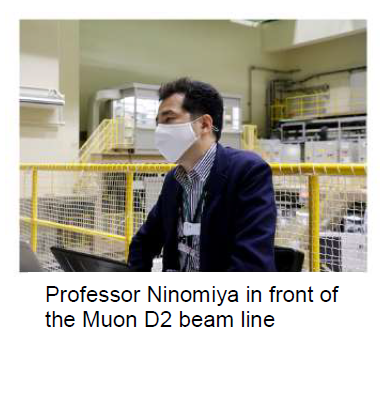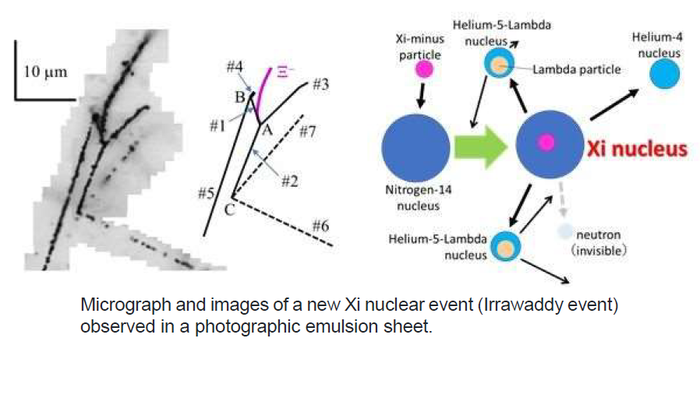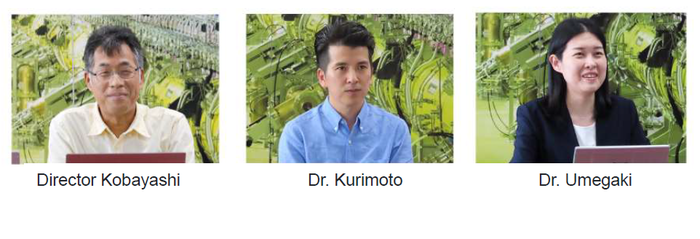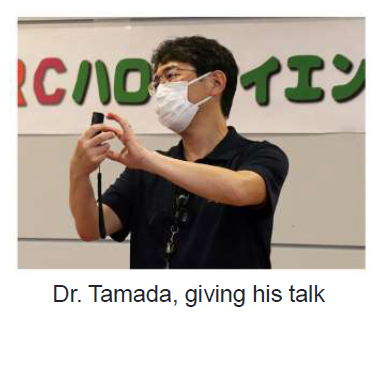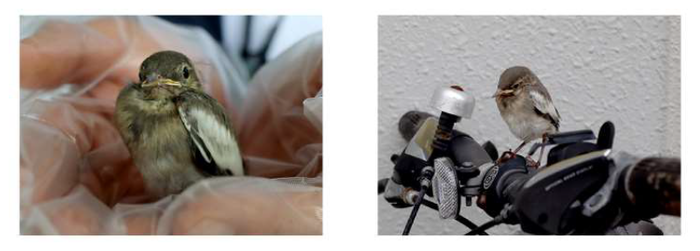J-PARC News July (Issue #195)
■ “Accelerators” Exhibition now on at National Museum of Nature and Science (July 13 to October 3)
We are introducing the history and development of accelerators in Japan, the basis of accelerators and the state-of-the-art research on the universe, as well as research results used in familiar places. Presented in ways that are easy to understand, the exhibition is taking place mainly in the large accelerator facilities of J-PARC and KEK Tsukuba Campus. Feel free to visit.
On July 24, we held a lecture titled “A tool for chasing dreams: accelerators” by Hitoshi Murayama, the MacAdams Professor of the University of California, Berkeley, and Professor of the Kavli Institute for the Physics and Mathematics of the Universe at the University of Tokyo Institutes for Advanced Study. According to the lecture, the accelerators are like a time machine, and large accelerators close in on the mysteries of the universe, materials, and life. We felt drawn to his story, the 40 minutes flew by. A video of the lecture is coming soon to the website, so keep an eye open for it.
Currently, to enter National Museum of Nature and Science, you need to make a reservation online in advance as a measure against COVID-19.
For details, please refer to following article. https://www.kahaku.go.jp/
■ Dissolution of hydrogen into iron blocked by sulfur during early Earth’s evolution (June 24, Press Release)
The current Earth core has a lower density than it would be if pure iron were assumed, and it is considered that light elements such as hydrogen, carbon, oxygen, silicon, and sulfur are dissolved in it. Riko Iizuka, a specially appointed assistant professor at the University of Tokyo, and others have been indicating that hydrogen may have dissolved into iron earlier than other light elements in the early stages of Earth’s formation. However, the influence of other light elements at that time was unclear.
This time, using a sample simulating the component materials of the Earth in the early stages of formation, in-situ observation was performed under high temperature and high pressure using neutron diffraction, and the effect of sulfur on the hydrogenation of iron was investigated. The experiment was carried out using the six-axis multi-anvil press “ATSUHIME” installed at PLANET high-pressure beamline in J-PARC. The results clarified that the hydrogenation of iron, which occurs when water stripped from hydrous minerals reacts with iron under high temperature and high pressure, is inhibited by coexisting iron sulfide. This suggests that it is very likely that hydrogen and sulfur were preferentially dissolved in solid iron, and then other light elements were dissolved in the molten iron later. In the future, to pursue the origin of water in the process of global evolution and its quantity, it is necessary to clarify when and to what extent other light elements were absorbed into iron through experiments that use multiple light elements.
■ Online press conference takes place to start sample analysis of asteroid Ryugu (June 25, Press Release)
The conference was broadcast from the Photon Factory (PF) at KEK Tsukuba Campus and the Muon Experimental Facility at J-PARC’s Materials and Life Science Experimental Facility (MLF). Professor Tomoki Nakamura of Tohoku University, the leader of the Stone Material Analysis Team, operated a Gandolphy X-ray camera that analyzes Ryugu samples using the PF’s synchrotron radiation BL-3A. Professor Yoshio Takahashi of the University of Tokyo used the PF’s BL-19A and Associate Professor Kazuhiko Ninomiya of Osaka University used the MLF’s Muon D2 to explain the characteristics of each beam line, experimental methods for samples or expected analysis results.
From June 28 to July 5, samples of asteroid Ryugu were brought to the Muon Experimental Facility, irradiated with high-intensity negative muons, and analyzed as planned. This is introduced in the extra edition of J-PARC News “Analysis of asteroid Ryugu samples started at J-PARC.”
■ Internal structure of the “Xi nuclei” finally observed successfully: New findings for understanding the origin of atomic nuclei and the structure of neutron stars (July 23, Press Release)
In order to know the origin of various atomic nuclei, which would explain the existence of a wide variety of substances around us, the key is to investigate the force interacting between particles such as “hyperons,” which are sister particles with the protons and the neutrons that make up atomic nuclei. Hyperons are similar particles to protons and neutrons and do not naturally exist on the Earth.
Senior Professor Kazuma Nakazawa of Gifu University and his collaborators conducted an experiment to irradiate a special photographic plate with a large amount of Xi particles (a type of hyperon) that were generated from a high-intensity, high-purity kaon beam produced using a J-PARC accelerator. The experimental group announced new results continuing from February this year. Analysis of the tracks of the particles left on the photographic plate revealed that the Xi-minus particles were bound to the nitrogen-14 nucleus with more than five times as much energy as the event that was reported in February. This indicates a state of being more strongly bound by the attractive force due to the “strong interaction” with the nucleus in addition to the Coulomb force. Furthermore, together with the data on the Xi nuclei detected so far, it has become clear that the Xi particles have discrete energies in the Xi nuclei (called the level structure). This may elucidate how the nucleus is made up of quarks, and also lead to an understanding of the internal structure of the neutron stars, which are the densest objects in the universe.
For details, please refer to following article. https://j-parc.jp/c/en/press-release/2021/07/23000727.html
■Debriefing session on industrial use of J-PARC MLF (July 15 to 16)
The purpose of this reporting meeting is to look back on the MLF’s efforts for industrial use and to lay out its future direction. It has been jointly hosted by four parties, the J-PARC Center, CROSS, Ibaraki Prefecture, and the Industrial Users Society for Neutron Application every year since 2017. The reporting meeting last year was canceled due to COVID-19. However, this year, 352 people participated in the online meeting. There was a strong request from the industry sector to know what neutrons and muons can tell us and how they can be used. For the next three years, we will focus on “what we can see with neutrons and muons” and “what we can use them for” to promote matching with what the people in the industry sector want to see.
This time, we proceeded with an agenda focusing on the following: (1) from the industry sector, to show the current state of use, what the industry sector wants from the facility, and what the necessary technology is; (2) from the facility side, to show the technology that the facility can supply and its limits; (3) from the joint research group, to show the results of the joint research started at MLF; and (4) reporting on cooperation with the research reactor JRR-3 and industrial use.
■ Three J-PARC researchers gave online lectures at Spring X Super School, hosted by KNOWLEDGE CAPITAL (July 3, 10, 17)
KNOWLEDGE CAPITAL hosts Spring X Super School as a place to learn “real knowledge” from specialists in various fields such as science, art, culture, and business, to think together, and to hold discussions. This time, three J-PARC researchers gave lectures on YouTube Live under the theme of “Life planning for junior and senior high school students: living as a researcher” for one hour each on Saturday for three weeks.
- First lecture “Explore the mystery of the universe at J-PARC”
Takashi Kobayashi, Director of the J-PARC Center
He explained the principle to “see” the microscopic world using particle accelerator, and introduced the accelerators and experimental facilities at J-PARC, and wide variety of science fields being studied at J-PARC, including why matter exists in the universe using neutrinos produced at J-PARC.
- Second lecture “How to create the strongest beam!"
Yoshinori Kurimoto, Associate Professor at High Energy Accelerator Research Organization, J-PARC Center’s Accelerator Division
The principle of acceleration, how to make a stronger accelerator, and the features of the J-PARC accelerators were introduced.
- Third lecture “How I became a corporate researcher working at J-PARC”
Izumi Umegaki, a researcher in Materials Analysis and Evaluation Research Domain at Toyota Central R&D Labs., Inc.
She introduced the twists and turns of her life until she became a corporate researcher, and gave a message to junior and senior high school students.
■ J-PARC Hello Science “‘Shape’ and ‘function’ of proteins explained with quantum” (June 25)
In June, “J-PARC Hello Science” was held in-person at iVil and online because Tokai Village was no longer subject to restrictions to stop the spread of coronavirus infection.
The lecturer this time was Dr. Taro Tamada of the Structural Biology Group, National Institutes for Quantum and Radiological Science and Technology. We can learn the function of proteins in life by obtaining their structural information. A protein is a “nanomachine,“ and the tertial structure of a protein composed of many atoms is determined by some methods using a quantum beam such as neutrons. He also introduced that the function of proteins can be explained by a new approach called “quantum structural biology,“ which could elucidate the mystery of life with “quantum theory” based on precise structural information.
■ Online lecture notice (August 25 p.m.)
Online lectures will take place on August 25 on the analysis status of asteroid Ryugu samples and expected analysis results. Lecturers will be Associate Professor Kazuhiko Ninomiya of Osaka University and Professor Koichiro Shimomura, Deputy Division Head of Materials and Life Science, J-PARC Center.
■ Sanpo-michi #13: Young white wagtail gets lost in our building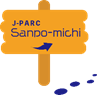
A young white wagtail was chirping under the stairs in the J-PARC Research Building. It seems that the wagtail had accidentally got inside the building when the automatic door opened. The white wagtail’s parent has a slender, monotone tail, however, this young bird has almost no tail and walks awkwardly, swings its soft gray body from side to side. When our staff held out his hands, the young bird went into them. The staff gently let the bird go outside the building, and it flew away by several meters at a time. We were worried that the young bird may be attacked by other animals, but left the area believing that the young bird would be with its parent.
It's been over a month since the young bird got lost in our building, and it was only for a few minutes, but the warmth of its downy feathers and the call for its parent are still unforgettable.
The total sample from the asteroid Ryugu brought back by Hayabusa 2 was 5.4 g, of which only 120 mg came to J-PARC. This sample stayed at Muon D2 at Materials and Life Science Experimental Facility, for about a week, and left soon after.
The Ryugu sample seems to have entered this human society as unwillingly as the young white wagtail. However, the knowledge obtained from it could offer great clues for humankind to find the home of life.



